Ticker Reports for September 14th
Individual Stocks vs. Index Funds: Which Is Right for You?
Good investing is all about making good choices, and one of the first crossroads you’ll come to as an investor is choosing between individual stocks or index funds. In some scenarios, this decision will be made for you, like investing in a 401(k) account. But suppose you’re choosing assets for an IRA or taxable brokerage account and forgoing a financial advisor. In that case, you’ll need to decide what combination of stocks and index funds to hold.
In this article, we’ll explain how stocks and index funds work and why you might consider investing in either asset. You’ll learn the benefits and drawbacks of adding stocks and index funds to your portfolio and how to form a preliminary assessment of your risk tolerance to determine the best asset balance.
Individual Stocks
When you buy stocks in your brokerage account, you’re buying a small piece of a publicly traded company and entitling yourself to a portion of that firm’s profits. Think of public companies as puzzles with millions of different pieces. Most pieces are held by the company’s executives, employees, and large institutions. However, anyone with a brokerage account (and enough capital to buy a share) can invest in one of these pieces.
For example, if you wanted to invest in the tech sector’s hottest trends, you might look at companies benefiting from the artificial intelligence boom, such as NVIDIA Corp. (NASDAQ: NVDA) and Advanced Micro Devices Inc. (NASDAQ: AMD). You can purchase shares of either company in your brokerage account, and if these firms report high profits, the value of the shares (and, therefore, your investment) will go up.
Benefits of Individual Stocks
Many books have been written about the fortunes earned from individual stock investments. And while not everyone can be early to the next NVIDIA, you can still improve your financial future with stocks. Here are four primary benefits of individual stock investing:
- Potential for Higher Returns - If you were an early investor in companies like NVIDIA or Amazon Inc. (NASDAQ: AMZN) and stayed the course over decades, you’re likely sitting on life-changing wealth. Individual stocks can be volatile, but if you find a generational company and remain invested, you could be looking forward to an early retirement.
- Voting Rights - Shareholders earn more than money from their stock; they also have a say in company decisions, such as electing board members or raising more capital.
- Dividends - Stock price appreciation isn’t the only way to profit from owning individual companies. Many firms return earnings to shareholders through quarterly dividends, which are paid out regularly and can provide consistently steady income.
- Customization - Investing in individual stocks allows you to build a personalized portfolio with as many (or as few) shares as you want. Index funds track a benchmark like the S&P 500, which means your portfolio construction is outsourced to fund managers or index constructors.
Drawbacks of Individual Stocks
Investing in individual stocks also comes with risks and negative consequences if you don’t know what you’re doing. In contrast with the list above, here are four cons of personalized stock picking.
- Higher Risk Than Index Funds - Index funds are diversified and less volatile than individual stocks, which makes them more appealing to risk-averse investors. The fewer stocks in your portfolio, the more you can expect to endure heavy drawdowns and volatility.
- Firm-specific Risks - Individual stocks also carry risks unique to the underlying company. For example, an index investor doesn’t need to worry much about CEO impropriety or an earnings miss since they own many companies in a single security. However, individual stock investors must be aware of any company-specific risk when buying shares.
- Time-consuming Research - Investors buying individual stocks choose from thousands of companies in various sectors and industries. Picking the proper stocks requires due diligence, which means listening to conference calls, reading analyst reports, and scouring financial documents while monitoring broader economic and geopolitical trends. Sounds like fun, doesn’t it?
- May Still Fail to Beat Benchmarks - Even after hours of meticulous research and precise stock selection, your investment portfolio could still lag the index. For many investors, there are simply too few hours in the day to monitor and update stock investments constantly.
Index Funds
Making an index fund is a bit like making an omelet. Some people want something simple like a cheese omelet, while others prefer heartier ingredients like a Western or Mexican omelet. Despite the different ingredients, they’re all omelets. Index funds are composed similarly - the ingredients may differ, but the basic recipe is the same.
Each index fund tracks a benchmark, such as the S&P 500 or the NASDAQ 100. Different indices follow stocks of various sizes and industries, but benchmark tracking is the fundamental similarity. No fund manager is trying to find the winners and eliminate losers; the fund simply tracks the underlying index by matching components.
Benefits of an Index Fund
Many of the mutual and exchange-traded funds (ETFs) in our IRAs and 401(k) accounts are index funds, and for good reason. Here are four key benefits of index investing:
- Instant Diversification - An index fund comprises all the stocks in the underlying benchmark. So, if you own a NASDAQ 100 index fund, you’ll own all 100 stocks in that particular index. Owning 100 (or more) stocks through a single security means you can instantly build a diversified portfolio.
- Cheaper than Active Funds - Actively managed funds have higher turnover and expenses, which can eat into investment returns (or anger investors if the fund underperforms). Index funds often carry expense ratios as low as 3 basis points.
- Set-It-and-Forget-It - Index funds are often the preferred vehicle of retirement savers because broad-based funds can be held for decades with minimal turnover. For many savers, worry-free retirement investing is better than a few points of outperformance.
- Simple and Efficient - With limited intervention, anyone can purchase index funds and expect them to perform reasonably well over long periods. Index funds' simple approach makes them appealing to novice and expert investors.
Drawbacks of an Index Fund
Index funds are simple and less risky, but that doesn’t mean they’re foolproof investments. Here are some critical downsides of index investing to remember when building your portfolio.
- Potential Underperformance - Index funds track a benchmark, nothing more. That hot stock outperforming the market? You’ll only own it in equal proportion to its benchmark weighing. If you dream about getting wealthy from well-research stock investments, index funds might leave you wanting more.
- Limited Selection - Although you’ll find a wide range of index funds, you’ll still be bound to their asset allocation and investment thesis. If you want to increase your weight in winners like NVDA or AMZN, you’ll want to buy the individual shares yourself.
- Tax Implications - Finally, index funds buy and sell assets to keep up with their benchmarks, which means stocks are bought and sold regularly. This can create tax complications if you receive a capital gains distribution you didn’t anticipate. Consider tax implications when buying index funds in taxable accounts (and use our tax calculator tool)
How Individual Stocks and Index Funds Differ
Index funds are made up of individual stocks, but that doesn’t mean the two assets share similarities. You’ll be subject to market risk and taxation with either vehicle, and you’ll need to understand your personal risk tolerance and investment plan before choosing either.
While they share specific characteristics, individual stocks are riskier than index funds since they have the potential for significant underperformance or irreversible capital loss. When investing in index funds, you protect yourself from the bankruptcy risk of an individual company. But if you invest in only a handful of stocks and one goes belly up, your portfolio could take a severe hit while the rest of the market chugs along unscathed.
How to Choose Which Is Right for You
Investment portfolios aren’t one-size-fits-all. Here are a few factors to consider when constructing your asset base:
- Time Horizon - How long do you plan on staying in the market? The time you keep your capital invested significantly influences returns in both types of securities, and people with long time horizons often have stronger stomachs for risk.
- Investment Goal - Are you investing for retirement or a first-time home purchase? Or are you simply trying to make as much money as possible with your free spending cash? The purpose of your investment helps inform your asset allocation, so consider your goals before building a portfolio.
- Risk Tolerance - Time horizon and risk tolerance are often related, but personal risk should be assessed when choosing assets. Can you tolerate volatility? If you have a concentrated stock portfolio, could you stick to the plan if your holdings lose 15% in a week? Indexing might be the best path if you’re prone to emotional buy or sell decisions.
Choosing Between Individual Stocks and Index Funds Requires Proper Risk Assessment
Buying a few shares of NVDA in your Robinhood account might be an exciting way to get individual stock exposure, but building a portfolio of individual stocks is an entirely different animal. Be sure to consult with a financial advisor before putting significant capital into individual stocks or index funds, and always understand your time horizon and goals.
Invest Smarter with MarketBeat
Individual stocks tempt investors with promises of massive gains, but picking winners in the stock market is difficult, even for those with professional research and market intuition. Indexing reduces risk by offering diversification through a single asset, but you usually buy some losers alongside the winners. Investors using MarketBeat’s tools and reports can make more informed decisions about asset allocation and make sure their portfolios align with their goals. Click here to start a free trial today.
"Doomsday indicator" flashing for the first time since the Great Depression...
It's been a bloodbath in the markets.
The seven most valuable US tech companies lost a combined $1 trillion - in a single day.
And things could get a lot worse...
3 Fresh Stock Buybacks: These are the Ones to Buy
MarketBeat.com tracked numerous buyback announcements in September, and the month is still ongoing. Buybacks are a sign of corporate strength and help build shareholder value, but not all buybacks are equal. Buybacks that reduce share count and build value can help drive stock prices higher over time; buybacks that only partially offset dilution are another story, and money going down a hole.
These are the stocks that present value to investors with robust, share count-reducing stock buybacks.
Rockwell Automation Buyback Plans Will Build Value
Rockwell Automation (NYSE: ROK) is the world’s largest industrial-focused automation company. It struggles with growth in 2024 but can sustain ample cash flow, balance sheet, health, and capital returns. The company announced a new $1 billion buyback authorization this month, giving evidence of the same. The board increased the existing allotment to $1.35 billion, or about 4.6% of the market cap, with shares trading near $255, and they are reducing the count.
The share count was down 1.2% average at the end of Q3, accelerating from the 0.75% reduction posted last year.
Repurchases are compounded by a dividend, which is worth nearly 2.0% on an annualized basis. The distribution is safe and growing with a payout ratio below 50%, long-term debt at less than 1X equity, and a fourteen-year history of increases. Sixteen analysts rate the stock as a Hold, with sentiment firming in recent revisions and expecting a 10% upside at the consensus.
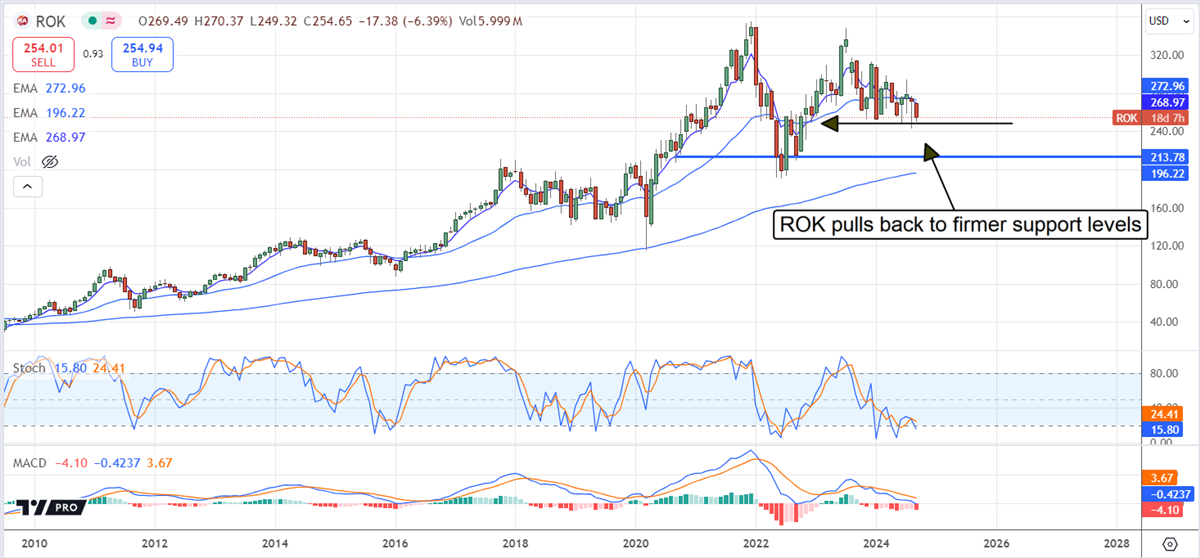
Helen of Troy Share Repurchases Reduced the Count by 2%
Helen of Troy (NASDAQ: HELE) has faced its share of hurdles and struggles over the past few years, but one thing is clear: This battle-tested consumer goods company has good management and rock-solid financials that can stand the test of time. The latest update is a new $500 million share repurchase authorization that replaces the old one. After an aggressive repurchase increase this year, the old one was worth only $55 million. The new $500 million is worth about 40% of the stock, a significant figure made more substantial by the pace of repurchases in Q1.
The Q1 activity reduced the count by 2% compared to last year, and this pace may be expected to continue. The balance sheet is a fortress with total debt at roughly 0.5X equity; revenue and earnings growth are expected to resume within three to four quarters. Three analysts rate this stock as a Hold. It presents a deep value today, trading 18% below the lowest forecasted price target.
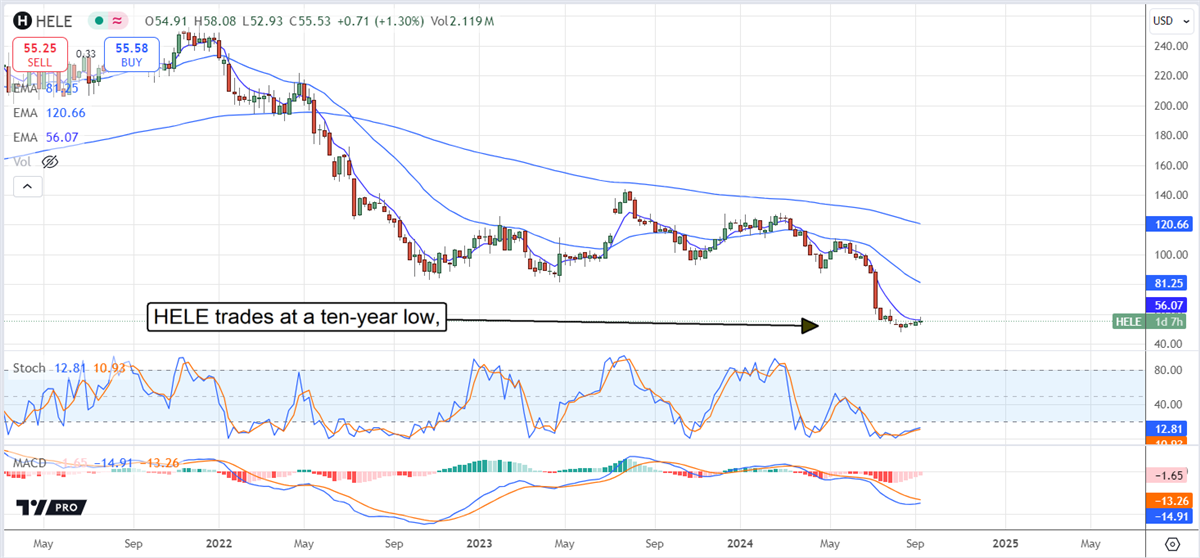
Autohome Inc. Buys Back Shares, Pays a High Dividend Yield
Autohome Inc. (NYSE: ATHM) is a digital automobile marketplace operating in China. It is a growing company with a healthy cash flow and a high-yielding dividend that gives insulated exposure to China’s EV market. The buyback news is that it initiated a $200 million authorization with an expiration date of twelve months. The expiration date is no guarantee, but it suggests that robust repurchases will be made this year, reducing the share count by 4.5% compared to the market valuation at the time of release.
MarketBeat.com tracks two analysts rating this stock. They peg it at a Hold and see it trading near fair value at $28. However, with only two revisions issued this year, the target has a low conviction. The institutional interest is more significant and bullish on balance for three consecutive quarters, increasing the total holdings to over 64% and providing a tailwind for the market.
The stock is trading at rock bottom levels, with shares moving up from the critical support level and bullish signals in the indicators, so upward movement is expected to continue. The signals aren’t strong, but the risk-reward profile is skewed in favor of the upside because the clearest target for strong resistance is about 30% above the current action.
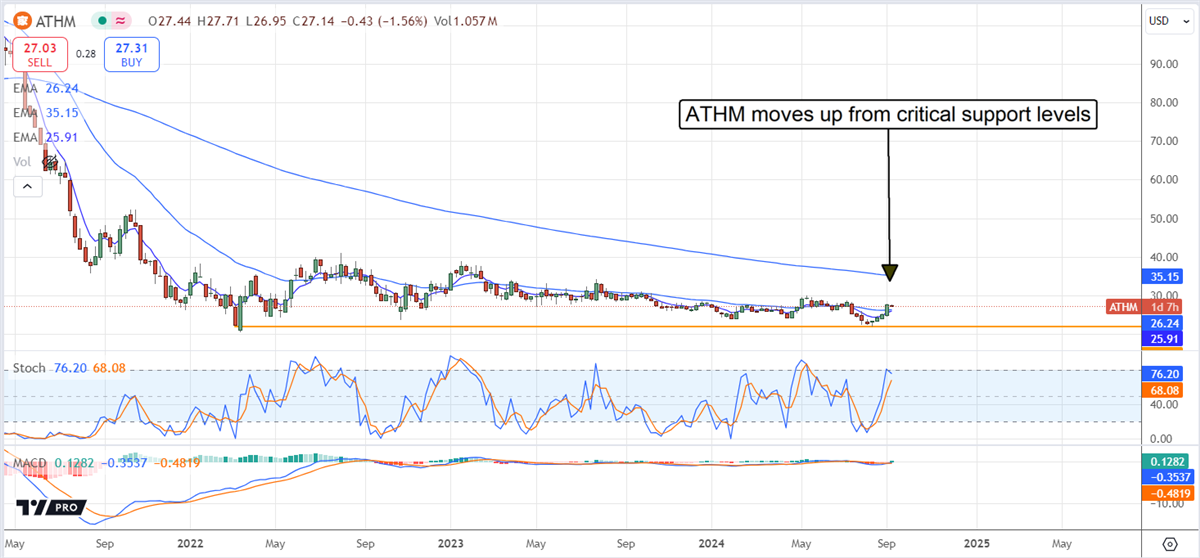
[SHOCKING] Crypto Document Leak…
A shocking leak has revealed Japanese electronics giant Sony is now starting its own blockchain.
This move is being made in preparation to onboard all of Sony products (including Sony's Playstation, which captured a record 62% share of the global gaming console market in 2024).
Enthusiasts and experts are buzzing with anticipation qnd one little-known crypto coin is poised for RAPID growth as we see this all unfold.
Tesla's New Buy Rating: Why Analysts Are Optimistic
It isn’t often that investors get to consider the more straightforward deals in Wall Street before they become too mainstream and recognized to get in, as when an investment is too popularized, the upside can often start to get priced into the stock and leave little to no upside left after everyone hears about the deal. Today, investors can get in before the rest.
There is a massive change happening in the global economy, as well as sentiment about tariffs and trade policy around the import and export of electric vehicles (EVs). Primarily, the United States and some European nations are starting to increase their tariffs (often as high as 100%) on Chinese electric vehicles. While that might affect stocks like BYD (OTCMKTS: BYDDF) and NIO Inc. (NYSE: NIO), there is one other player in the space that is set to win more market share.
That stock is Tesla Inc. (NASDAQ: TSLA), which is more than just an automotive stock. Most need to realize that Tesla is working on other breakthroughs in the technology sector, combining recent breakthroughs and combining them with the energy and automotive sectors as well. This is the new angle taken by Wall Street analysts when boosting the stock, another tailwind coupled by the global tariff initiative.
How Tesla's Market Share Could Be Impacted by Upcoming Tariffs
There is no alternative to BYD in international markets other than Tesla. It seems that the latter has already been adopted widely throughout Europe and North America, so the recent tariffs will only accelerate Tesla’s market share takeover in these and other regions.
But these tariffs probably won’t stop there. As Tesla now expands its manufacturing operations to Mexico and other countries for more efficient labor costs, these countries might adopt the same view to favor Tesla over Chinese EVs as new jobs are created to grow and boost their own economies.
Every government loves to push their infrastructure spending bills higher at each chance they get, so welcoming Tesla factories to their turf means a few billion in necessary investment to build the needed infrastructure to not only manufacture these EVs but also the charging stations needed to sustain them once bought.
Now that the stock trades at only 80% of its 52-week high price, investors have a new chance to close down the gap to the upside, especially as most of the stock market indexes now trade at much higher levels relative to highs. Here’s where Wall Street analysts see the catalyst to deliver this new run higher.
Accelerating Tailwinds Prompt Wall Street Analyst to Boost Tesla Stock
Investors would expect that Tesla’s sales in China would drop as a result of the world placing tariffs on Chinese EVs, making companies like BYD and NIO take on measures to regain market share in their domestic markets. However, that’s not the case today.
Tesla reports a 15% jump in China deliveries over the third quarter measured last year, and up to 16,200 insurance registrations were seen during early September 2024, up 12% from the prior weekly measure. Despite tariffs and potential loss of market share, China is still letting Tesla operate freely on its home turf, and the upside is now more apparent.
Analyst Ed Yu from Deutsche Bank recently resumed his coverage of Tesla stock, this time placing a “Buy” rating coupled with an optimistic price target set as high as $295 a share. To prove this new target right, the stock would have to rally by as much as 28.2% from where it trades today.
Not only that but the overall consensus for earnings per share (EPS) growth is now set at 44% for the next 12 months in Tesla stock. Driving this growth is the fact that Tesla is not only a car manufacturer; according to Yu, Tesla is a ”technology platform attempting to reshape multiple industries.”
And he’s not wrong. As mentioned, Tesla is helping drive countries to invest in infrastructure to support alternative energy sources, which includes solar panels installed by the company to help streamline the charge and energy storage process for Tesla vehicles.
Facing all this potential upside and bullish momentum, bears decided to retreat from the company. Tesla stock’s short interest declined by 5.8% over the past month to show bearish capitulation, leaving additional room for other buyers to come in.
And that they did; out of the $25.7 billion of institutional capital that came into the stock over the past 12 months, those at Ameriprise Financial decided to boost their holdings by up to 10.7% as of August 2024, netting their investment at up to $941 million today.
There is one more gauge for investors to consider when wondering whether this sentiment and valuation is realistic for Tesla stock. Through a valuation comparison, it becomes clear that markets are willing to pay a significant premium for Tesla compared to the rest of the auto sector.
As the company trades at 58.2x price-to-earnings (P/E) ratio, it is significantly above the auto sector’s average 10.3x valuation. There is typically a good reason for markets to pay premiums for specific stocks, and Tesla is no exception.


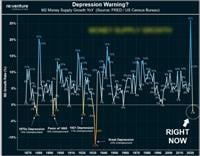
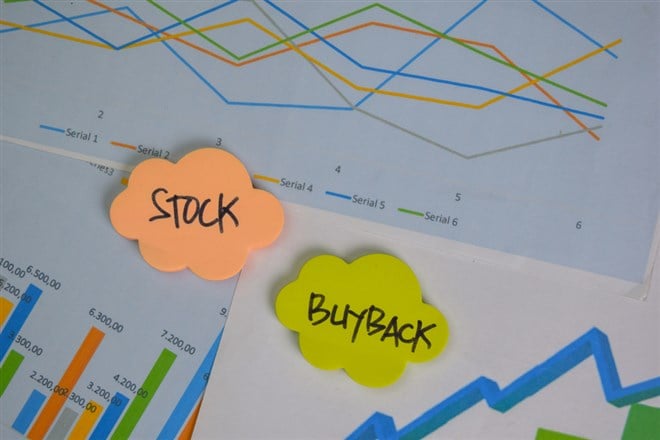
![[SHOCKING] Crypto Document Leak…](https://www.marketbeat.com/images/webpush/files/thumb_2059push_crypto-3569795_640.jpg)

0 Response to "🌟 3 Fresh Stock Buybacks: These are the Ones to Buy"
Post a Comment